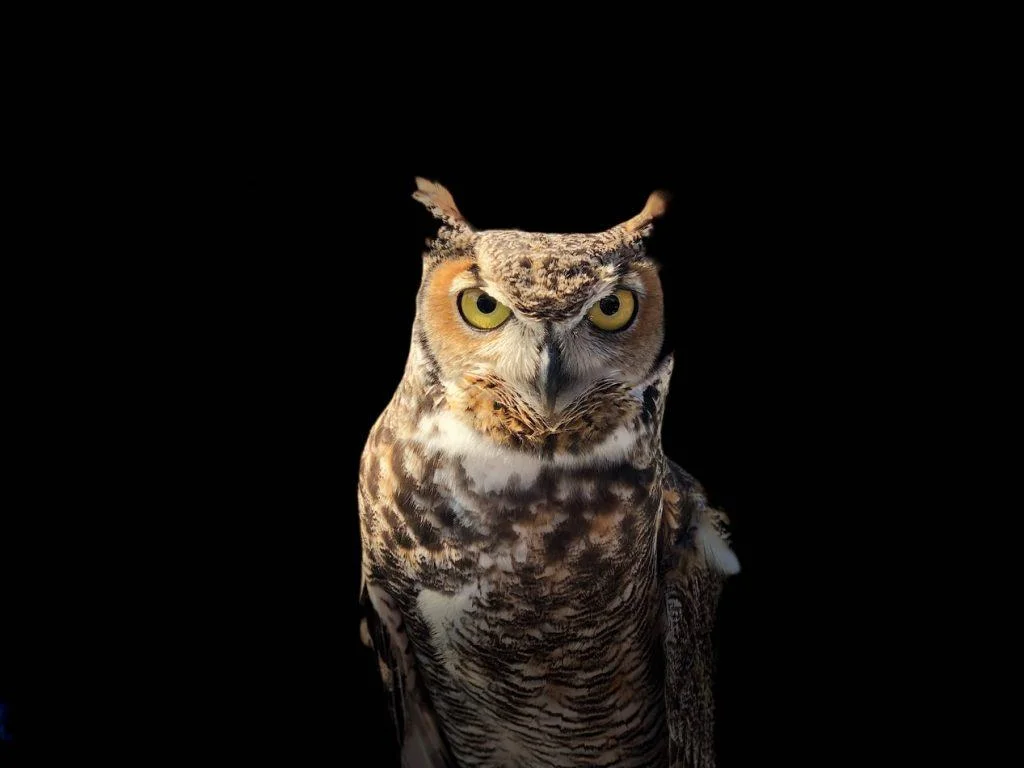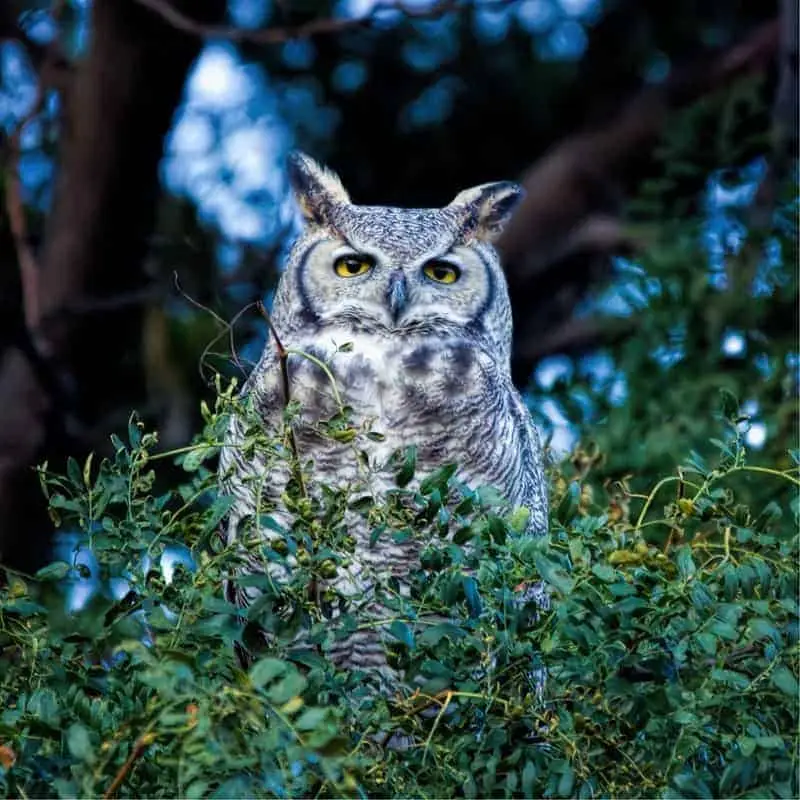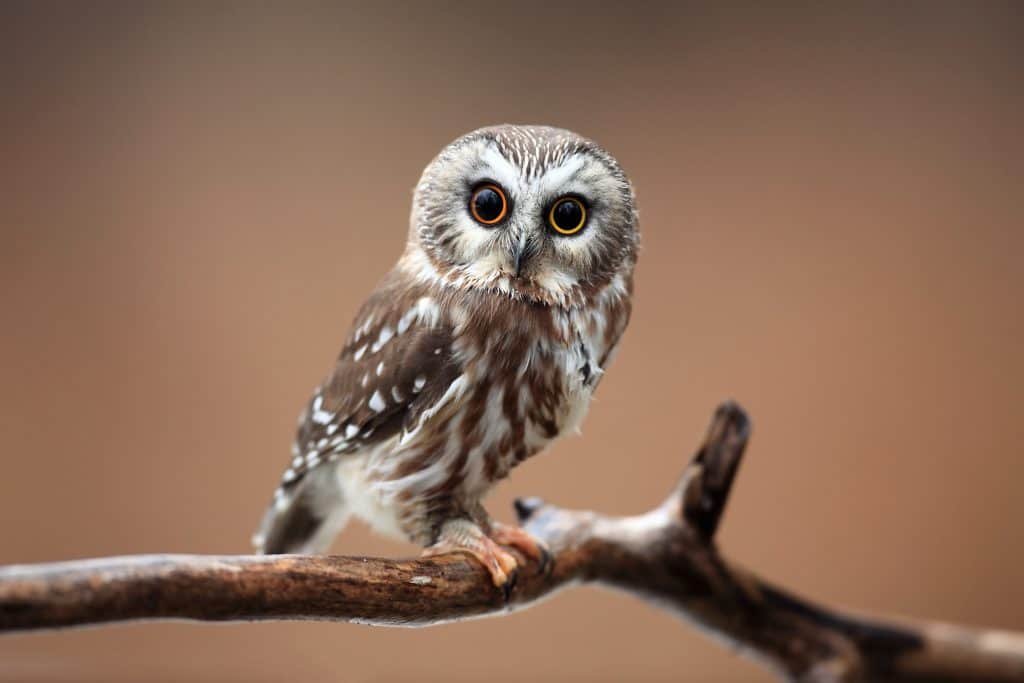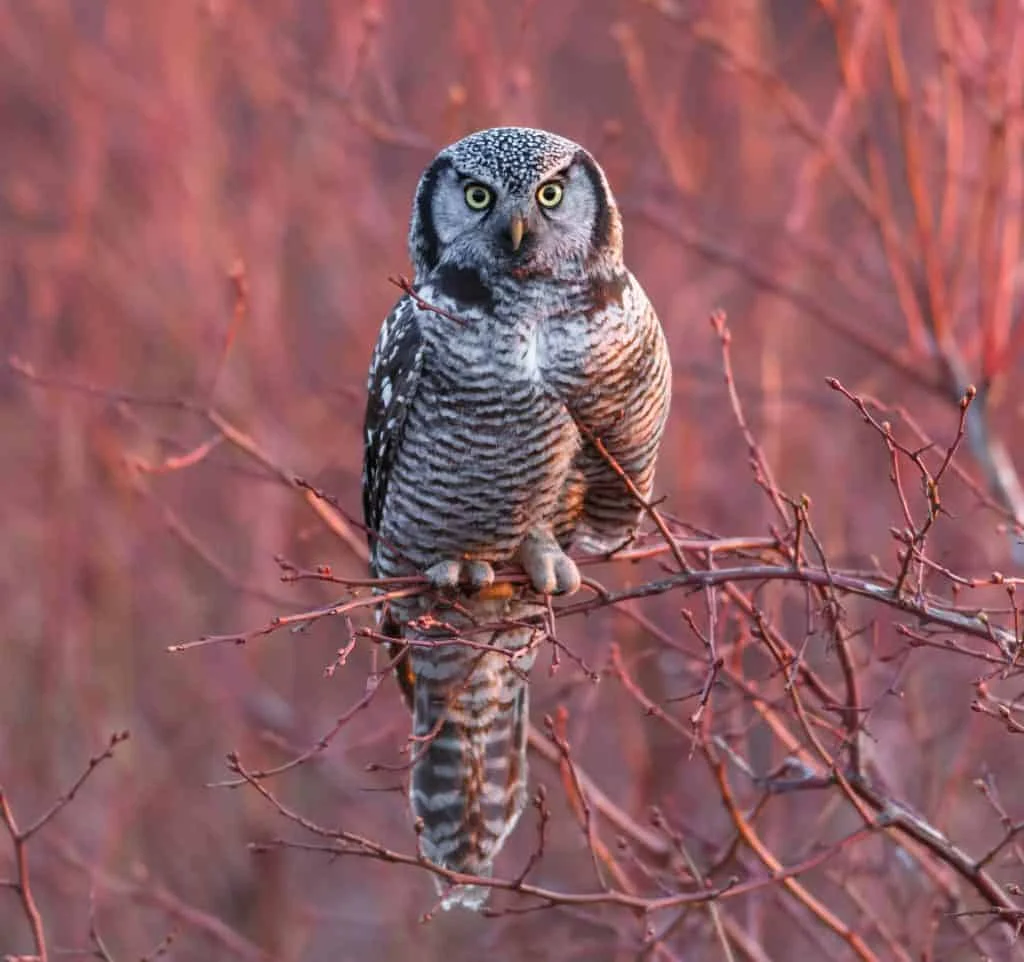
In Minnesota, you may encounter 12 different species of owls across various regions of the state.
These 12 species are the Barn Owl, the Eastern Screech-Owl, the Great Horned Owl, the Snowy Owl, the Northern Hawk Owl, the Burrowing Owl, the Spotted Owl, the Barred Owl, the Great Gray Owl, the Long-eared Owl, the Short-eared Owl and the Northern Saw-whet Owl.
Want to learn more? This National Geographic Book on Owls is a great read!
The Great Horned Owl is the most common of all of these as it is the most commonly found and widespread species of owl throughout the united states.
Minnesota has a continental climate which means that the state has hot and humid summers with cold and crisp winters.
There are 67 different state parks across Minnesota and there are 5 different national parks, one of these is shared with the neighboring state of Wisconsin.
After looking at Minnesota in a little more detail, lets explore the 12 different owl species that you can find in the state.
Want to attract Owls to your yard? Take a look at our article!
What Owls can be seen in Minnesota?
Table of Contents
1. Barn Owl

Wingspan
107 to 110 cm
Weight
430 – 620 g
Life Expectancy
Up to 4 years
Diet
Voles, Shrews & Mice
The Barn Owl can appear to be completely white in certain types of light, but they are actually covered in pale brown and grey feathers with only their belly being white in colour.
This owl has a large range that spans over 48 different states and is one of the most common species of owls across North America.
Females of this species will use their breeding nest year-round, which is uncommon for a lot of owls, and you are most likely to see one of these nests in open grassland areas.
Whilst Barn Owls form long term breeding pairs and mostly remain monogamous, there have been recording of males mating with several different females in the same breeding season.
These birds are year-round residents in the state of Minnesota but they are not seen across the whole state.
Their habitat only extends to the south of the state but there have been recorded sightings in the north east.
2. Eastern Screech Owl

Wingspan
46 to 61 cm
Weight
160 g
Life Expectancy
14 years
Diet
Rats, Squirrels, Rabbits & Skunks
The Eastern Screech-Owl has sharply shaped, long ear tufts and a unique pattern of grey feathers that help it to camouflage against trees.
These owls are not particularly fussy about where they habituate, any area with dense enough trees will suffice. However, in more recent years they appear to have expanded their nesting range to more suburban areas including places such as city parks.
Males are very defensive of their territories and they form stable breeding pairs with either one or two females.
Both of the individuals in the mating pair will help to raise the young and males will bring food to the female nursing the fledglings
These owls are permanent residents in the state of Minnesota and can be found in most regions of the state.
They are most active during their breeding seasons and the highest number of recorded sightings are in the south east of the state.
3. Great Horned Owl

Wingspan
~140cm
Weight
1.4 kg
Life Expectancy
28 years old
Diet
Squirrels, Rabbits & Skunks
The Great Horned Owl has long and sharp looking ear tufts, these ear tufts resemble the horns mentioned in its name.
These owls are medium in size and whilst these birds are most commonly found in denser woodlands, they can also breed and nest successfully in suburban areas such as city parks.
Both males and females are monogamous and form breeding pairs, both individuals will help to protect the nest.
They are very territorial, and their aggression has known to be extended as far as killing other members of their own species.
The breeding pairs are long lasting, and they will both remain in their territory outside of the breeding season; however, they will roost separately.
With their vast range it is not surprising that these owls are permanent residents in Minnesota and they can be seen throughout all regions of the state.
Whilst their distribution across the state seems to be fairly even, there appears to be a higher number of recorded sightings along the eastern border of the state.
4. Northern Saw-whet Owl

Wingspan
40 - 60 cm
Weight
100 g
Life Expectancy
7 years
Diet
Small birds, young squirrels, voles & shrews
The Northern Saw-Whet Owl has a big round head and wide orange eyes and it is one of the much smaller species of owl.
Their wings and their backs are covered in brown feathers of different shades and have similar patterns to each other.
Contrasting this their bellies are bright white. These birds will only nest in dense woodland areas and if they will make their nest in the most mature forest that they can find.
The density of the forest becomes a bigger factor in the winter and breeding seasons, they need much denser woodlands during these times.
Whilst most males are completely monogamous, in seasons of high prey abundance, some males have been known to mate with another individual.
The level of prey abundance is the only thing currently known to affect the levels of monogamy. However, breeding pairs will be formed in each subsequent breeding season as they do not form long term mates.
Because of their small size, these owls are also often preyed on by a variety of larger owl species, including several that we have previously looked at in this article.
These owls can be seen throughout all of Minnesota. They are permanent residents in the northern half of the state whilst they can only be seen in the southern half outside of their breeding season.
The highest number of sightings have been recorded along the western border of the state.
5. Short-Eared Owl

Wingspan
85 to 110 cm
Weight
206–475 g
Life Expectancy
4-12 years
Diet
Voles, Mice, Squirrels
This owl has ear tufts that are so small they cannot be seen, hence why it got its name.
These owls are medium sized for an owl species and have brown feathers spotted with buff that cover all of their bodies.
They make their nesting habitats in large areas of open grasslands. Their level of activity and sleeping patterns changes depending on the season and they tend to be active at all hours of the day and night when it reaches the breeding season.
They will spend a lot of the daytime doing courting displays for females so will use the night to do some extra hunting. After mating, the male’s primary role is to protect the female whilst she incubates the eggs.
They will do this by performing distraction displays to intruding individuals to deter them away from their nesting site and this is often done to animals of much bigger size.
These birds have a similar range to the Long-eared Owl and can only be seen in the north of Minnesota during their breeding seasons.
They can be seen in the south of the state throughout the year and the highest number of recorded sightings being to the far south.
6. Snowy Owl

Wingspan
150 cm
Weight
2 kg
Life Expectancy
10 years
Diet
Birds, Rabbits, Fish & Rodents
The Snowy Owl is much more common in arctic areas rather than in the United States but there have been various sightings in different states.
Its body is covered in bright white feathers that help it camouflage against the snow in its tundra habitat.
The courting display of this bird involves the male will drop a lemming, or another item of prey, next to the female as a gift to her. He will only do this after performing a flight display of long dives for her.
These owls are very territorial and can be very aggressive to anyone trying to enter their habitat.
There have been recorded incidents of pairs attacking an arctic wolf as well as dive bombing humans that move too close to their habitats.
These owls rarely go into the United States, but they have been seen in Minnesota during the winter months. This is because they go south to deal with the cold.
There have been recorded sightings throughout Minnesota, but the highest amount of sightings are in the north west of the state.
7. Long Eared Owl

Wingspan
90 to 100cm
Weight
250 g
Life Expectancy
4 years
Diet
Small mammals, mice, rats & rabbits
This owl has some of the largest ear tufts of all owl species which is where it gets its name from.
These owls are medium in size and have stout bodies covered in dark feathers and orange faces. They are very territorial and therefore require larger spaces for their habitats.
These habitats are usually open grasslands and coniferous woodlands. These birds form loosely structured colonies that often make which can reach a number of 100 individuals outside of the breeding season.
During the breeding season the number of individuals in the colony will decrease but they will still nest close to each other.
Males remain monogamous and begin courting a female during the late winter, before the colonies are fully formed.
There is speculation as to whether these breeding pairs are long-term or if a male will mate with a different individual from the colony in subsequent seasons.
These birds have an incredibly wide range and they can be seen in all areas of Minnesota. However, they can only be seen in the northern half of the state during their breeding seasons. The most common number of sightings have been recorded in the south west of the state where they are year-round residents.
8. Northern Hawk Owl

Wingspan
45 cm
Weight
300 -340 g
Life Expectancy
Up to 16 years
Diet
Rodents & Small Mammals
The Northern Hawk Owl does not get its name from its looks but instead gets it from its behavior.
It looks similar to lots of other owl species with a large circular head and thick feathers that are brown and white.
These owls reside in coniferous woodlands and seem to prefer making their nests in burnt areas of forests. They will hunt mostly during the day and use a swooping method to catch their prey.
During the breeding season males will only court and hunt within the bounds of their territory.
These birds are monogamous but the pairs only stay together for one breeding season. They remain solitary for the rest of the year but are not aggressive to other Northern Hawk Owls that pass through their territory.
These owls are not permanent residents in Minnesota and can not be commonly seen in the state. They are only in Minnesota during the cold winter weather. Most of the sightings have been to the north western regions of the state.
9. Great Grey Owl

Wingspan
Up to 152cm
Weight
1.1 kg
Life Expectancy
12 years old
Diet
90% small rodents
The whole body of this owl is covered in feathers of various shades of grey.
You are most likely to see this large owl in evergreen woodland areas, the denser the better. These owls usually hunt at night but during the winter and breeding seasons they will also hunt during the daytime when prey is more greatly needed.
Great Gray Owls form breeding pairs that nest together during the mating months.
They separate outside of the breeding seasons and it is not known as to whether the breeding pairs are long term or if they mate with a different individual each year.
These owls have a range to the north of the united states, but they can be found in Minnesota outside of their breeding seasons.
They can only be seen in the northern half of the state, with the most sightings being in the north eastern regions.
10. Burrowing Owl

Wingspan
51-61 cm
Weight
140-240 g
Life Expectancy
10 years
Diet
Large Insects and Small Rodents
The Burrowing Owl is small in size for an owl and their feathers are brown and white in colour.
These owls tend to live in open grassland areas, they can also be seen in open suburban areas such as cemeteries. They will hunt on the ground as often as they can and they have been known to hunt throughout the day and the night.
Females will often stay inside the burrows with their young whilst the males will stay on the surface near to the burrows. Whilst the female is raising the young the male’s job is to protect the nest.
These birds are mostly monogamous but will occasionally mate with a few different individuals.
These birds are not permanent residents of the state and can only be seen in Minnesota during their breeding seasons.
There have only been a small number of sightings in Minnesota and all of these have been recorded along the western border of the state.
11. Barred Owl

Wingspan
96-125 cm
Weight
468-1,150 g
Life Expectancy
10-23 years
Diet
Small mammals
The barred patterns on its wings made by its feathers are what gives this owl both its name and its most identifiable feature.
These bars are brown and white in colour. These owls are most commonly found in mixed woodland areas and like to stay in woods that are close to swamps and marshlands.
These owls spend their day roosting and will hunt at night, a common practice for lots of owl species.
Both males and females are defensive of their territory and they form breeding pairs that remain monogamous to each other.
It is thought that these breeding pairs are long term and they are thought to mate for life although this is not fully confirmed.
These birds have a wide range across the eastern states and are permanent residents in the state of Minnesota.
They can be seen in all areas of the state but are most commonly found to the north east of Minnesota.
12. Spotted Owl

Wingspan
114cm
Weight
600g
Life Expectancy
16-21 years
Diet
Small mammals
The Spotted Owl is known for the brown and white spotty pattern that covers its feathers.
These feathery spots are most prevalent on their belly. These owls are most often found in mature forests and usually denser areas of woodland if they are available.
These owls are monogamous birds and they will form breeding pairs that will mate for several seasons.
The pair will begin roosting together a few weeks before they begin mating and will spend a lot of this time preening each other’s feathers.
Fledglings will usually stay with their parents for about 3 months before breaking off and going alone.
There are several different subspecies of Spotted Owl and the one you will see in the state of Minnesota is the Northern Spotted Owl.
They can be seen in the state throughout the year but they are not commonly found there. The only sightings of this bird have been recorded to the south west of the state.

More Articles.

How to attract Woodpeckers to your yard?
Woodpeckers are often elusive to the sight but distinct to the ears. Their famous pecking

How to Attract Crows to your Yard?
Crows are one of the most iconic birds across the world; instantly recognizable by their

Best Binoculars for Bird Watching 2020
Article Summary: Best Budget Binoculars: Nikon 8250 Aculon 16×50 Best Mid-tier Binoculars: Nikon Monarch 5

About Us
We are avid bird-watchers who recently retired, allowing us more time to travel the world. Fortunately, we have managed to visit numerous countries around Europe, Asia, and America. Watching and photographing birds has been a passion for many years and we are making the most of the extra time on our hands!
